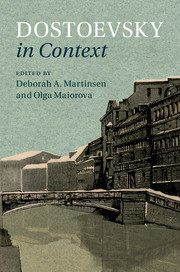Book contents
- Frontmatter
- Contents
- List of illustrations
- Notes on contributors
- Acknowledgments
- Note on citation, transliteration, glossary, and dates
- Chronology
- 1 Introduction: the many worlds of Dostoevsky
- PART I SOCIAL, HISTORICAL, AND CULTURAL CONTEXTS
- i CHANGING POLITICAL, ECONOMIC, AND SOCIAL LANDSCAPE
- ii POLITICAL, SOCIAL, AND CULTURAL INSTITUTIONS
- iii SPACE AND PLACE
- iv RELIGION AND MODERNITY
- 21 Orthodox spirituality
- 22 Religious dissent
- 23 Roman Catholicism
- 24 Islam
- PART II LITERATURE, JOURNALISM, AND LANGUAGES
- Glossary
- Further reading
- Index
- References
23 - Roman Catholicism
from iv - RELIGION AND MODERNITY
Published online by Cambridge University Press: 18 December 2015
- Frontmatter
- Contents
- List of illustrations
- Notes on contributors
- Acknowledgments
- Note on citation, transliteration, glossary, and dates
- Chronology
- 1 Introduction: the many worlds of Dostoevsky
- PART I SOCIAL, HISTORICAL, AND CULTURAL CONTEXTS
- i CHANGING POLITICAL, ECONOMIC, AND SOCIAL LANDSCAPE
- ii POLITICAL, SOCIAL, AND CULTURAL INSTITUTIONS
- iii SPACE AND PLACE
- iv RELIGION AND MODERNITY
- 21 Orthodox spirituality
- 22 Religious dissent
- 23 Roman Catholicism
- 24 Islam
- PART II LITERATURE, JOURNALISM, AND LANGUAGES
- Glossary
- Further reading
- Index
- References
Summary
The age of Dostoevsky was an era of challenge, upheaval, and transformation for Catholicism in Europe and Russia. Such symbolically charged events as the pope's flight to Gaeta from the insurgents led by Mazzini and Garibaldi in 1848, the First Vatican Council in 1869–70, and the solemn promulgation of the dogma of papal infallibility in 1870 – to name the most remarkable – loomed large in the international politics of the day and on the minds of many contemporaries, shaping an image of Catholicism that has survived into the twentieth century. Fyodor Dostoevsky thus had many reasons to remain steadfastly interested in Roman Catholicism.
Beginning in the 1830s, the Catholic Church in various countries increasingly faced the rise of secular nationalism and anticlerical liberalism, often accompanied by atheistic ideas. The complex process of Italian unification, for which the Papal State proved to be a major hindrance, powerfully raised the question of the pope's temporal domains as opposed to his spiritual authority and divine mission. This question intensified the debates on the separation of church and state – a modern idea that gradually found its way into the legislation of France, Italy, Austria, Prussia, and, later, the German Empire. Catholicism thus served as a critical testing ground for efforts to demarcate the boundaries of the state's administration of faith from faith itself, bureaucratic function from clerical ministering, external rituals from inner spirituality.
Catholics viewed the political conflicts and tensions as a secular response to the religious revival underway since the end of the Napoleonic Wars. Originating mostly in France and quickly spreading eastward, this return of religiosity counteracted various modes of alienation from, or indifference to, church and faith that had been conditioned by the Enlightenment and furthered by the French Revolution. Throughout the second quarter of the nineteenth century, Catholic piety was restored in truly novel or reinvented forms. Aided by the newly constructed railroads, better means of communication, and a far-reaching popular press, religious practices such as missions, pilgrimages, and veneration of miracle-working icons and relics acquired a stunningly mass scale.
This wave of enthusiasm, however, was not completely spontaneous but went hand in hand with the strengthening of ecclesiastical discipline. In the process of reclaiming its flock from the claws of irreligion, the clergy enhanced their own authority and consolidated church hierarchy. Regular (i.e., monastic) clergy became far more prominent.
- Type
- Chapter
- Information
- Dostoevsky in Context , pp. 202 - 208Publisher: Cambridge University PressPrint publication year: 2016



